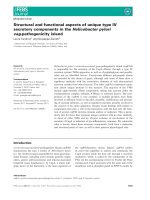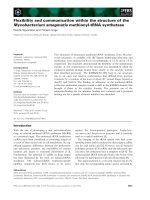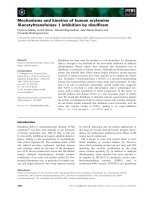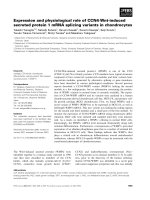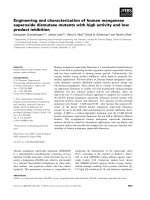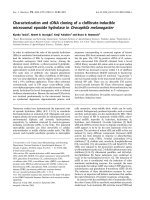Báo cáo khoa học: "COMPARATIVES AND ELLIPSIS " potx
Bạn đang xem bản rút gọn của tài liệu. Xem và tải ngay bản đầy đủ của tài liệu tại đây (515.35 KB, 6 trang )
COMPARATIVES AND ELLIPSIS
s. G. Puhnan
SRI International, and University of Cambridge Computer Laboratory
SRI International Cambridge Computer Science Research Centre
23 Miller's Yard, Cambridge CB2 1RQ
ABSTRACT
This paper analyses the syntax and seman-
tics of English comparatives, and some types
of ellipsis. It improves on other recent analy-
ses in the computational linguistics literature in
three respects: (i) it uses no tree- or logical-form
rewriting devices in building meaning represen-
tations (ii) this results in a fully reversible lin-
guistic description, equally suited for analysis or
generation (iii) the analysis extends to types of
elliptical comparative not elsewhere treated.
INTRODUCTION
Many treatments of the English comparative
construction have been advanced recently in the
computational linguistics literature (e.g. Rayner
and Banks, 1989; Ballard, 1988). This interest
reflects the importance of the construction for
many natural language applications, especially
those concerning access to databases, where it is
natural to require information about quantita-
tive differences and limits which are most nat-
urally expressed in terms of comparatives and
superlatives.
However, all of these analyses have their de-
fects (as no doubt does this one). The most per-
vasive of these defects is one of principle: they
all place a high reliance on non-compositional
methods (tree or formula rewriting) for assem-
bling the logical forms Of comparatives even in
cases that might be thought to be straightfor-
wardly compositional. These devices mean that
the grammatical descriptions involved lack, to
varying extents, the important property of re-
versibility: they can only be used to analyse, not
to generate, expressions of comparison. This is
a serious restriction on the practic,'d usefulness
of such analyses.
The analysis presented here of the syntax
and compositional semantics of the main instances
of the English comparative and superlative is in-
tended to provide a fairly theory-neutral 'off the
shelf' treatment which can be translated into
a range of current grammatical theories. The
main theoretical claim is that by factoring out
the compositional properties of the construction
from the various types of ellipsis also involved, a
cleaner treatment can be arrived at which does
not need any machinery specific to this construc-
tion A semantics in terms of generalised quan-
tifiers is proposed.
SYNTAX
Intuitively, a sentence like:
John owns more horses than Bill owns
seems to consist of two sentences ascribing owns
ership of horses, together with a comparison of
them, where some material has been omitted.
Despite appearances, however, this pre-theoretical
intuition is ahnost wholly wrong, both syntacti-
cally, and, as we shall see, semantically. The
sequence 'more horses than Bill owns' is in fact
an NP, and a constituent of the main clause, as
can be seen from the fact that it can appear as
a syntactic subject, and be conjoined with other
simple NPs:
[More horses tha~ Bill owns] are sold
every day
John, Mary, and [more linguists than
they could cope with] arrived at the
party
In order to accommodate example like these
we must analyse the whole sequence as an NP,
with some internal structure approximately as
follows. (We use a simple unification grammar
formalism for illustration, with some obvious no-
tational abbreviations).
NP[-comp] -> NP[+comp,postp=P,<feats~,R>]
S ' [+comp, postp=P, <feats=R>]
A [+comp] NP is one like:
a nicer horse, a less nice horse, less
nice a horse, several horses more
several more horses, as many horses,
at least 3 mot, I,,:~rses, etc.
-2-
We will not go into details of the internal
structure of these NPs, other than to require
that whether the comparative element is a de-
terminer or an adjective, the dominating NP
carries feature values which characterise it as a
comparative NP, and which enforce 'agreement'
between comparative pre- and post-particles (-
er/than,as/as, etc.) via the variable 'P'. We as-
sume that NPs marked as comparative in this
way are not permitted elsewhere in the gram-
nlar.
In the case of the [+comp] S' constituent,
there are several possibilities. Some forms of
comparative can be regarded as straightforward
examples of unbounded dependency construc-
tions:
more horses than Bill ever dreamed
he would own _
more horses than Bill wanted ~ to
run in the race
These involve Wh-movement of NPs. The see-
ond type involving a lnissing determiner depen-
dency:
John owns more horses than Bill owns
_ sheep
There were more horses in the field
than there were _ sheep.
Rules of the following form will generate [+comp]
sentences of this type, using 'gap-threading' to
capture the unboullded dependency:
S' [+comp,postp=P, <feats=R>]
->
COMP [form=P]
S [-comp, gapIn= [CAT [<f eat s=R>] ], gapOut= [] ]
(.here CAT is either NP or Det)
As well as these 'movement' colnparatives
are those involving ellipsis:
John owns more horses than Bill/Bill
does~does
Bill/sheep.
Name a linguist with more publica-
tions than Chomsky.
lie looks more intelligent with his glasses
off than on.
It is noteworthy that sentences like the sec-
ond of these dernonstra.te that the appropriate
level at. which ellipsis is recovered is not syn-
tactic, but semantic: there is no syntactic con-
stituent in the first portion of the sentence that
could form an appropriate antecedent. We there-
fore do not attempt to provide a syntactic mech-
anism for these cases, but rather regard them as
containing another instantiation of an
S' [7+compJ
introdnced by a rule:
S'[+comp]
-> COMP
S[+ellipsis, -comp]
An elliptical sentence is not a constituent re-
quired solely for comparatives, but is needed to
account for sentence fragments of various kinds:
John, Which house?, Inside, On the
table, Difficult to do,
John doesn't, He might not want to,
etc.
All of these, as well as more complex se-
quences of fragments (e.g. 'IBM, tomorrow' in
response to 'Where and when are you going?')
need to be accommodated in a grammar.
Very many cases of this type of ellipsis can
be analysed by allowing an elliptical S to consist
of one or more phrases (NP, PP, AdjP, AdvP)
or their corresponding lexical categories. Most
other commonly occurring patterns can be catered
for by allowing verbs which subcategorise for a
non-finite VP (modals, auxiliary 'do', 'to') to ap-
pear without one, and by adding a special lexical
entry for a main verb 'do' which allows it to con-
stitute a complete VP. Depending, of course, on
other details of the grammar in question the lat-
ter two moves will allow all of the following to
be analysed:
Will John?, John won't, He may do,
tie may not want to, Is he going to?
etc.
With this treatment of ellipsis, our syntax will
be able to analyse all the examples of compara-
tives above, and many more. It will also, how-
ever, accept examples like:
John owns more horses than inside.
Bill is happier than John won't.
for there is no syntactic connection between
tile main clause and the elliptical sentence. We
assume that some of these examples may actu-
ally be interpretable given the right context: at
any rate, it is not the business of syntax to stig-
matise them as unacceptable.
Comparatives with adjectives and adverbial
phrases, are,
mulalis mulandis,
exactly analo-
gous to those with NPs, and we omit discussion
of them here.
-3-
SEMANTICS
In tile interests of fanailiarity the analysis will
be presented as far as possible in an 'intension-
less Montague' framework: a typed higher order
logic.
Firstly, we need tile notion of a generalised
quantifier. It is well known that most, if not
all, complex natural language quantifiers call be
expressed as relations between sets. Specifically
(Barwise and Cooper, 1981) a quantifier with a
restriction R and a body B can be expressed as
a relation on the sizes of the set satisfying R,
and the set which represents the intersection of
the sets satisfying R and B. A quantifier like 'all'
can be represented using the relation =, and so a
sentence like 'all men are mortal', in a convenient
notation, will translate as:
quant(~nna.n=m,)~x.man(x),)tx.mortal(x))
(In logical forms, lower case variables will be of
type e, and upper case variables will be of type
e ~t unless indicated otherwise. All functions
are 'curried': thus Sxy.P is equivalent to SxAy.P.
Read expressions like 'quant(Q,R,B)' as 'the re-
lation Q holds between the size of the set de-
noted by R, and the size of the set denoted by
Sx.lLx&Bx'. This latter is tile intersection set.
The important thing to note at this point is
that the relation Q can be arbitrarily complex,
as it needs to be in order to accommodate de-
terminers like 'at least 4 but not more than 7'.
The second important thing to notice is that for
many quantifiers, we are only interested in the
size of the intersection set, and thus tile first
lambda variable in Q will be vacuous. Thus
'some' can be expressed as the relation ')mm.m
_ 1', as in 'some men snore':
quant(,~nnl.m > 1, )~x.man(x)/~x.snore(x))
In tile case of the movement types of compara-
tive we can give the semantics in a wholly com-
positional way by building up generalised quan-
tilters which contain tile comparison. Informally,
the gist of the analysis is that in a sentence like
'Jolm owns more horses than Bill owns', there
is a generalised quantifier characterising the set
of horses that John owns as being greater than
the set of horses that Bill owns. hfformally, we
can think of the complenaent of a comparative
NP as a complex determiner:
John owns [more than Bill owns] horses
(Ill this respect, as in the use of generalised
quantifiers, this analysis yields logical forms some-
what similar to those of Rayner and Banks, 1989).
rio build these quantifiers we assume that the
various relations signalled by the comparative
construction are part of the quantifier. Thus the
final analysis of the example sentence is:
quant($nm.more(rn,
Sx.horse(x)& own(Bill,x)),
)~y.horse(y),)~z.own(John,z))
'More' (or 'less' or 'as') is the relation used to
build the quantifier. To avoid notational clutter
we call assume that 'more' is 'overloaded', and
can take as its arguments either a number, or
an expression of type e ,t, in which case it is
interpreted as taking the cardinality of the set
denoted by that expression. 'More' in fact takes
a third argument, which is another quantifier
relation. Thus the meaning of a sentence like
'john owns at least 3 more horses than Bill owns'
would get a logical form like
quant(Anm.more(m,Aab.b_> 3,
Ax.horse(x)&own(Bill,x)),
Ay.horse(y),Xz.own(john,z))
The way to read this is 'the relation of being
more (by a number greater than or equal to 3)
than the size of the set of horses owned by Bill,
hol:ds of the set of horses owned by John'. Where
this extra argument to 'more' is not explicit, we
assume it defaults to 'greater than 0'. Itowever,
we;shall ignore this refinement in the illustra-
tioias that follow).
~Note that this quantifier is only interested in
the intersection set: this is always true of com-
parative quantifiers.
:We now give the meanings of each constituent
involved in a couple of examples, along with the
relevant rules, in skeletal form. We indicate the
trail of gap threading using the 'slash' notation.
For the purposes of this illustration we use the
analysis of the semantics of unbounded depen-
dencies from Gazdar, Klein, Pullum and Sag
(1985): a constituent C containing a gap of cat-
egory X is of type X ,C. So given a tree of the
form [A [B C]] which might normally ],ave as
the interpretation of A as B applied to C, the
interpretation of a tree [A/X [B C/X]] would be
',~X.B(C(X))'. Since gaps themselves are anal-
ysed as identity fimctions this will have the right
type.
-4-
/
NP
I
John
S
\
VP
/ \
V
NP
I / \
omas
NP S
'
/ \ /
Det Nbar Comp
/ f f
more horses
than
\
s/sP
/ \
HP
VP/NP
I I \
Bill
V
NP/NP
I J
owns e
The relevant rules and sense entries in schematic
form are:
S * NP VP : NP(VP)
VP V NP : V(NP)
NP -* NP[+comp] S' :NP(S)
S' * Comp S/NP : Ax.S(AP.P(x))
S' -¢ Comp S/Det : Ax.S(APQ.P(x) Ir Q(x))
S/Gap ~ NP VP/Gap : AG.NP(VP(G))
VP/Gap ~ V NP/Gap : AG.V(NP(G))
NP/NP -~ e : AN.N
NP/Det -~ Nbar : AD.D(Nbar)
NP ~ bill : AP.P(bill)
NP -~ Det Nbar : Det(Nbar)
Det ~ more :
APQIt.quant (Anm.more(m,
Ax.Px & Qx),Ay.Py, Az.Rz)
Nbar ~ horses
:
Ax.horse(x)
V * owns : ANx.N(Ay.owns(x,y))
'Gap' abbreviates either NP[-comp] or Det,
and G is a variable of the appropriate type for
that constituent. N is an NP type variable; D a
Det type variable, as are their primed versions.
Notice that comparative determiners and their
NPs are of higher type than non-comparative
NPs, at least for those analyses which analyse
relative clauses as modifiers of Nbar rather than
NP. Constituent meanings are assembled by the
rules above as follows:
[NP+cemp more horses]:
AQR.quant (Anm.more(m,
Ax.horse(x)&:
Q(x)),
Ay.horse (y),Az.it(x))
[VP/NP owns ,]:
AG.[ANx.N (Ay.owns (x,y))] ([AN'.N']
G)
= AG.Ax.G (Ay.owns(x~y))
[S/NP Bill owns el:
AG'.[AP.P (bill)/([AG.Ax.G (Ay.owns(x,y))] G')
=
AG'.G'(Ay.owns (bill,y))
IS' than Bill owns el:
=
Ax.[AG'.G'(Ay.owns (bill,y)/(AP.P (x))
= Ax.owns(bill,x)
[NP [more horses][S' than Bill owns el:
AR.quant(Anm.more(m,
Ax.horse(x) Y.,
own(bill,x)),
Ay.horse(y),Az.R(z))
The remainder of the sentence is straightforward.
The second example for illustration is:
John owns more horses than Bill owns. sheep.
For the subdeletion cases, a fully compositional
treatment demands a separate sense entry for
'more', since the Nbar of the NP in which 'more'
appears does not occur inside the comparative
quantifier:
APQR.quant (Anm.more(m, Ax.Qx),
Ay.Py, Az.Rz)
We do not have to multiply syntactic ambigui-
ties: the appropriate sense entry can be selected
by passing down into the NP a syntactic fea-
ture value indicating whether tile following S'
contains an NP or a Det gap. Constituents are
assembled as follows: remember that D has the
type of ordinary determiners: (e +t) ,((e +t) ~t).
[NP/Det e
sheep]: AD.D(As.sheep(s))
[VP/Det owns • sheep]:
AD'.[ANx.N(Ay.owns(x,y))] ([AD.D(As.sheep(s))]D')
= AD'.Ax.[D' (As.sheep(s))/(Ay.owns(x,y) )
[S/Det Bill owns e sheep]:
AD'.([D'(As.sheep(s))] (Ay.own~ (bill,y)))
[S' than Bill owns e sheep]-"
Ax.[
AD'.([D' (As.sheep(s))/(Ay.owns (bill,y)) )]
(APQ.P(x) ~" Q(x))
= Ax.sheep(x) & owns{bill,x)
[NP+eomp more horses]:
AQR.quant (Anm.more(m, Ax.Qx),
Ay.horse(y),Az.R(z))
[NP more horses
than Bill owns e sheep]:
AQIt.[quant(Anm.more (m, Ax.Qx),
Ay.horse(y),Az.tt(z))]
(Ax.sheep(x) & owns(bill,x))
=
AR.quant(Anm.more(m,
Ax.sheep(x) ~ owns(bill,x)),
Ay.horse(y),Az.It(z))
The final logical form for the whole sentence is:
quant(Anm.more(m,
Ax.sheep(x) & owns(bill,x)),
Ay.horse (y) ,Az.own (john,z))
-5-
ELLIPSIS
In order to explain our treatment of ellipsis,
we need more about the actual logical forms pro-
duced compositionally for sentences. These are
the 'quasi logical forms' (QLF) of Alshawi and
van Eijck (1989), differing from 'resolved logi-
cal forms' (RLF) in several respects: they con-
tain 'a_terms' representing the memlings of pro-
nouns and other contextually dependent NPs;
'a.fornm' (anaphoric formula) representing
the
meanings of sentences containing contextually
determined predicates (possessives, compound
nominals, 'have' 'do' etc); and 'q_terms' rep-
resenting the meaning of other quantified NPs
before the later explicit quantifier scoping phase
(see Moran 1988). QLFs are fleshed out to RLFs
via a process of contextually guided inference
(Alshawi, 1990). Since ellipsis is clearly a con-
textually deternfined aspect of interpretation we
extend the 'a_form' construct to provide a QLF
for elliptical sentences, and treat the process of
interpretation as akin to reference resolution for
pronouns.
Take a sequence like (A) 'Who came.'?' (S)
'John'. We represent the meaning of the 'miss-
ing' constituent by an 'a_form' binding a vari-
able of the appropriate type to combine with the
meaning of the 'present' constituents to form an
expression of the appropriate type for the S' con-
stituent containing the ellipsis. Thus the mean-
ing of the two utterances will be represented as:
past(come(who))
a_form(P,P(john))
One can think of 'a_form' as asserting that there
is such a P: resolution finds *that P. For consis-
tency with the Montague notation we are using
we will indicate an 'a_form' variable as a free
variable: 'P (john)'.
for P. In this example the only possibility is that
P = Ax.past(come(x)). Thus the meaning of the
elliptical sentence after resolution is:
[Ax.past (come(x))] (john)
= past(come(john))
The theoretical advantages of higher-order
unification in the interpretation of ellipsis are
amply documented in Dalrymple, Shieber, and
Pereira (forthcoming). More details of our own
treatment are in Alshawi et hi. (forthcoming).
This analysis of inter-sentential ellipsis gen-
eralises cleanly to intra~sentential ellipsis, in par-
ticular the comparative cases discussed above:
the only difference is that location of the 'con-
text' is not trivial, since the ellipsis is, as it were,
contained in the logical form that yields the con-
text. As an example, the NP in 'Name a linguist
with [more publications than John]' will have a
structure:
[NP [NP more publications] [S' than
[S-I-elliptical [NP John]]]]
The meaning of the elliptical S will be as above,
but the appropriate version of the semantics for
the S' rule will (as was the case with the analy-
sis of the movement comparatives given earlier)
have to arrange things so that the type of the
whole elliptical S' expression is e *t. Thus the
variable representing the ellipsis will be of type
e *(e ~t), assuming that 'john' in this context
is of type e. Omitting some of the details, the
meaning of the entire NP will then be:
AR.quant(Anm.more(m,
Ax.publications(x) ~" [P(john)](x)),
Ay.publicatlons(y), Az.R(z))
where the meaning of the elliptical S' [P(john)]
figures in the second term of the comparison af-
The ellipsis resolution method uses a tech- ter beta~reduction. Tile meaning for the whole
nique which is formally a restricted type of higher- sentence, again taking some short cuts will he:
order unification (Ituet 1975). Ellipsis resolution
proceeds ill three steps. Firstly, we have to find
a 'context', which in the case of intersentential
ellipsis is the logical form of the preceding utter-
ance. Next, one or more 'parallel' elements are
found in this context. In the example above, it
would be 'who'. This step is somewhat analo-
gous to the establishing of prououn antecedents,
and may be similarly sensitive to properties like
agreement, focus, sortal restrictions, etc. When
the parallel element(s) have been found, the next
step abstracts over the position(s) of the ele-
ment(s), and suggests the result as a candidate
name(hearer,linguist) &
quant(Anm.more(m,
Ax.publications(x) ~ [P(john)](x)),
Ay.publlcations(y), Az.have(linguist,z))
We now have to find a suitable context for el-
lipsis resolution. The only candidate expression
with an element parallel to 'john' is 'Az.have(linguist,z)'.
Abstracting over the parallel element gives us
'Alz.have(l,z)', which is an appropriate candidate
for P. After substituting and reducing the final
meaning of the whole sentence will be:
-6-
name(hearer,linguist) £z
quant (Anm.more(m,
Ax.publications(x) ~ have(john,x)),
Ay.publications(y), Az.have(llnguist~z))
In reality, of course, the details are more com-
plex than this, but this semi-formal reconstruc-
tion should convey the basic principles. Now
we have succeeded in analysing all the types of
comparative so far discussed using either purely
IMPLEMENTATION STATUS
Morphology, syntax and compositional seman-
tics for NP, AdjP and AdvP comparatives of
both movement and ellipsis types have been fully
implemented, as well as some other common types
of comparative not mentioned here (e.g. Nbar
comparatives like 'more men than women'). El-
lipsis resolution has been implemented for the
inter-sentential cases, but not, at the time of
writing, for the intra-sentential cases. However,
compositional means, or a non-compositional de-
. r . we foresee no problem here, as this is an exten-
vlceIor contextuallnterpretatlon ofelhps~s whose . ~ .
• . . stun o~ existing mecnamsms.
mmn properties, however, are mohvated on grounds
other than its use for comparatives. Further-
more, once we have this type of ellipsis mecha-
nism in place, it is a simple matter to extend it
to account for comparatives in which the whole
comparison is missing:
John has 2 more horses.
There are at least as many sheep.
ACKNOWLEDGEMENTS
This work was supported by the CLARE con-
sortium: BT, BP, the Information Engineering
Directorate of the DTI, RSRE Malvern, and SRI
International. I thank Hiyan Alshawi for his
many substantial contributions to the analyses
described here, and Jan van Eijck and Manny
As Rayner and Banks somewhat ruefully note, Rayner for comments on an earlier draft.
these are in many texts by far the most corn-
monly encountered form of comparative, although
their analysis, in common with others, fails to
handle them.
Syntactically, what we do is to give the vari-
ous comparative morphemes an analysis in which
they are marked as [-comparative]. Thus a phrase
like 'at least as many sheep' will be analysed as
either a + or - comparative NP. In the first case,
tile syntax will only permit it to occur with an
explicit complement, as detailed above, and in
the second case the syntax will prevent an ex-
plicit complement occurring. Semantically, how-
ever, the second contains an elliptical compari-
son. Thus the meaning of 'more' in this type of
comparative will be:
AP Q.quant (Anm.more(m,
2x. P(x) & R(x)),
~y.P(y),2z.(Q(z))
where R represents the meaning of the missing
constituent• In a context where 'John has more
REFERENCES
Alshawi, H. (et al.) forthcoming 'The Core
Language Engine', MIT Press.
Alshawi, H. (1990) Resolving Quasi-Logical
Forms, Computational Linguistics 16.
Alshawi, H. and van Eijck, J. (1989) Logical
forms in the Core Language Engine, Proceed-
ings :of 27th ACL, Vancouver: ACL
Ballard, B. (1988) A General Computational
Treatment of Comparatives for Natural Lan-
guage Question Answering, in Proceedings of
26th: ACL, Buffalo: ACL
Barwise, J. and Cooper, R. 1981 Generalised
Quantiflers and Natural Language, Linguis-
tics and Philosophy, 4, 159-219
Gazdar, G., Klein, E., Pullum. G. and Sag, I.
(1985) Generalised Phrase Structure Gram-
mar, Oxford: Basil Blackwell
Huet, G. (1975) A Unifcation Algorithm for
Typed Lambda Calculus, Jl. Theoretical Com-
puter Science, 1.1, 27-57.
horses' follows a sentence like 'Bill has some horses'~Cloran, D. B. (1988) Quantifier Scoping in
R should be resolved to 'ha.have(bill,a)'. Notice
that it may be necessary to provide interpre-
tations for 'more' in these contexts correspond-
ing to both the NP-gap and the Det-gap cases:
the elliptical portion is different depending on
whether the preceding sentence was 'Bill has some
horses' or 'Bill has many sheep': the latter is like
the Det-gap type of explicit comparison.
the Core Language Engine, in Proceedings of
26th ACL, Buffalo: ACL
P~yner, M. and Banks, A (1989) An Imple-
mentable Semantics for Comparative Construc-
tions, Computational Linguistics, 16.2, 86-
112
Dalrymple, M., Shieber, S., and Pereira, F.
(forthcoming) Ellipsis and Higher Order Uni-
fication, Linguistics and Philosophy.
-7-

